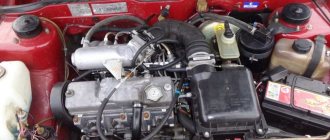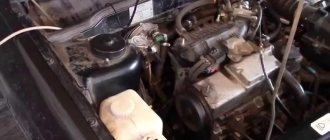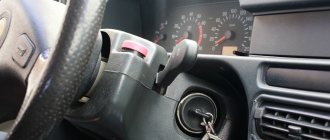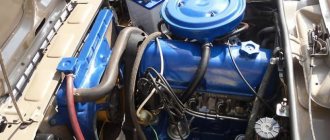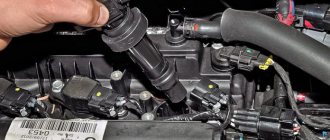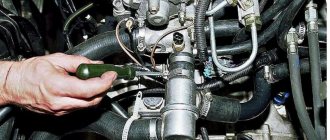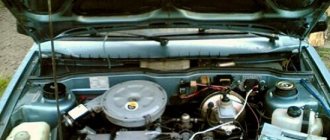Print this article Font size 16
If interruptions regularly occur during the operation of the car engine, and the sound emanating from the exhaust pipe is more like the growl of a tractor, this indicates that your engine is having problems. This problem needs to be solved, and quickly.
SIGNS AND REASONS OF “ADJUSTMENT”
Signs:
Engine trouble: what is it, and what are the signs to identify this malfunction? You can understand that the internal combustion engine is malfunctioning by the following signs:
- At idle speed, the engine operates unevenly, jerking periodically;
- The car does not develop the required power when driving;
- The car drives jerkily, when you press the gas pedal, there are gaps in operation;
- The exhaust from the muffler is uneven, with interruptions, pops and shots are possible;
- Fuel consumption increases.
Increased fuel consumption hurts your pocket Reasons:
There are many reasons why the engine misfires. There are such nuances that even experienced technicians do not immediately determine the nature of the malfunction. But the most common cylinder failures are the following (starting with the elementary ones):
- The candle does not work;
- The high-voltage wire is broken;
- The ignition coil has failed;
- The control unit is faulty;
- There is an air leak in the intake manifold;
- Exhaust valve burnt out;
- The cylinder head gasket is broken;
- The compression rings on the piston are broken,
- The piston itself has burned out, or the bridge on the piston between the compression rings has burst.
This article is about the VAZ 2114 car, so carburetor malfunctions are not considered, since this device was not installed on the 2114 model. This brand of car has a fuel system with distributed injection (injector), and the answer to the question of why the engine stalls may be hidden in this system.
Main reasons
The following reasons can lead to such a breakdown:
- low level of compression in the cylinders (for example, due to poor valve fit);
- injector contamination - the injection system is disrupted as a result of poor flow or fuel overflow;
- lack of spark supply to the spark plug - due to a malfunction of the spark plug or high-voltage wire;
- air filter contamination;
- control unit failure;
- malfunction of the crankshaft position sensor;
- change in position, or initial incorrect installation of the timing belt.
Failure of one cylinder can lead to breakdown of the entire engine. The gasoline that enters the idle cylinder does not burn out and mixes with the oil. As a result, the oil loses its properties and engine parts begin to wear out.
Engine operating principle
VAZ 2114 ENGINE CHARACTERISTICS
The VAZ 2114 car is mainly equipped with an 8-valve 4-cylinder engine, the fuel system and ignition are controlled by an electronic unit (ECU). The electronics have many different sensors that inform the unit about the condition of the engine. The control unit, in turn, reads the necessary information and gives commands to those devices that directly affect the operation:
- Distributes the spark among the cylinders in a certain order;
- Determines the required amount of supplied fuel (leans or enriches the fuel mixture depending on the number of revolutions).
The electronic control system of the VAZ 2114 contains the following sensors:
- Crankshaft position sensor (CPS);
- Camshaft position sensor or phase sensor (DPRV);
- Idle air regulator (or sensor) (IAC);
- Throttle position sensor (TPS);
- Knock sensor (DS);
- Air flow sensor or flow meter (AFM);
- Lambda probe or oxygen sensor.
Failure of any of these sensors leads to unstable engine operation, and if the DPKV fails, the car most likely will not start at all. Fuel is supplied to each cylinder using an electronically controlled injector. A faulty injector can also cause poor engine performance.
What to do?
There are a number of measures that are recommended to be taken when it is discovered that the engine is tripping. All of them will allow you to answer certain questions. Therefore, get ready to devote a lot of time to your car.
The first thing you need to do is identify the failed cylinder. He's not alone there. To do this you need:
- Open the hood while starting the engine;
- Listen and remember the sound your engine is making now;
- Remove the wires from the spark plugs one by one. If you remove the high voltage wire, the sound should change. If, when removing the next high-voltage cylinder, the sound does not change, congratulations, you have found the faulty cylinder.
Now we dismantle the problematic spark plug and check it for functionality. To do this, you will need a special wrench designed specifically for removing spark plugs:
- Pay attention to the electrode. If it is clean and intact, but there is a lot of burning on the head, most likely there is a large amount of dust in the combustion chamber. This indicates a malfunction of the air filter in the air supply system;
- If soot is present on the head and the electrode, which is noticeably burnt out, the mixture is poor, combustion occurs with premature ignition;
- If the head is burnt, but the electrode is intact, the mixture was rich and the ignition was delayed;
- Check for spark. If it is, then the problem needs to be looked for further. When there is no spark, it is recommended to replace it with a new one and check the performance of the engine with a new spark plug.
If your car has quite an impressive mileage, it is recommended to perform the following operations to identify the causes of the “triple”:
- Replace spark plugs;
- Dismantle the old high-fibers and replace them with new, high-quality ones. Sometimes banal microcracks on them lead to breakdowns and failure of the entire power unit;
- Measure the compression in the cylinder that is not firing. When detecting violations, you may determine that the valves are burnt out or the problem is in the rings;
- Perform valve adjustments. In general, a similar procedure is carried out at intervals of 15-20 thousand kilometers for the purpose of prevention;
- Check if the ignition coil is working. A common problem for the VAZ 2114. There is no point in trying to repair it; it is better to immediately replace it with a new one. It won't cost you a fortune;
- Replace the old air filter with a new similar unit;
- Check that the timing belt is installed and functioning correctly.
Even if these measures did not produce any results, we advise you to try a few more effective methods for restoring engine performance:
- Check the operation of the electronic control unit. If problems are detected, immediately replace the old electronic control unit with a new one;
- Check the functionality of the fuel supply system. In some cases you will have to get all the way to the injectors;
- Analyze the operation of the oxygen sensor. It can be repaired, but it would be better to replace the device immediately;
- Make sure the crankshaft position sensor is working properly. This is determined using an electronic control unit. It will display an error indicating that there is a problem. If there are problems with the sensor, there is nothing else to do but replace it with a new one.
REASONS FOR UNSTABLE OPERATION OF MOTOR 2114
Let's consider several standard situations that can happen with an 8-valve 4-cylinder engine.
UNSTABLE OPERATION ON A COLD ICE
It often happens that a VAZ 2114 stalls when cold, but as it warms up the engine levels out and starts working stably. There could be several reasons:
- The ECU sets the fuel mixture too rich to cold;
- The spark plug does not work, but when heated, the spark plug still “breaks through”;
- The high-voltage wires are damp or moisture has entered the ignition coil;
- Parts of the piston group are worn out.
UNSTABLE OPERATION OF A HEATED ENGINE
It also happens the other way around - a cold internal combustion engine operates more or less steadily, but as it warms up it begins to throttle. Usually the engine starts when hot because:
- The cylinder head gasket has burned out;
- The ignition coil breaks;
- The engine control unit is faulty.
Engine control unit for VAZ 2114
THE MOTOR STARTS AT IDLE SPEED
Most often, a situation arises when the engine stalls at idle speed. Moreover, it makes no difference whether this happens when it’s cold or when it’s hot. There can be many reasons for this, ranging from a simple spark plug failure to malfunctions in the piston group of the internal combustion engine. While it is very easy to replace a spark plug, wear on the cylinders in the block can lead to a major overhaul.
Most often, the engine does not operate stably at idle in the following cases:
- The valves are not adjusted (clamped);
- The timing belt is installed incorrectly (the marks do not match);
- The IAC is faulty;
- The cylinder head valves are bent or burnt out (the valves can bend during a water hammer when a large amount of water gets into the air filter housing);
- The piston burned out;
- There is a malfunction in the electronic engine control system. The sensors, the ECU itself, electrical wiring and I/O wires may be to blame here.
There are many options for why the car idles at idle, but there are still the most basic ways to determine faults.
How to fix the problem?
After the reasons why the VAZ 2114 engine is tripping have been determined , it is necessary to act depending on the situation:
- If there are problems in the ignition system, replace the broken spark plug or high-voltage wires.
- If the reason is in the fuel injection system or compression level, clean the injectors with ultrasound, adjust or replace the valves, air filter, check the position of the timing belt.
If these actions do not lead to results, you need to check and, if necessary, replace:
- Control block;
- crankshaft position sensor;
- oxygen sensor.
Thus, engine tripping is a common breakdown that, with experience and skillful hands, can be corrected on your own. If the cause of the tripping is a breakdown in key systems (control units) or there is no special equipment at home (for example, for cleaning injectors with ultrasound), it is recommended to contact a service station.
Where did the term “troit engine” come from?
The term “troit engine” appeared in the era of automotive development, when vehicle power plants were equipped with four-cylinder engines. If, for one reason or another, the working cylinder stopped functioning, then three cylinders remained in operation, which during operation made a characteristic sound, as if the engine was stalling in a damped mode.
Subsequently, despite the complication of the design of the piston group and the increase in the number of cylinders, the term “troit engine” remained in use among car enthusiasts.
Consequences
If the VAZ-2114 engine has an injector (8 valves), then the internal combustion engine immediately loses power. After all, on three cylinders everything is different. Another typical symptom for the VAZ line is vibrations and trembling from the engine compartment. Another symptom of the “disease” is increased fuel consumption and a distinct, rich smell of gasoline from the exhaust pipe and in the gases. And that's not it. It is important to respond to emerging signals in a timely manner, otherwise the car will require serious repairs.
When one cylinder is not functioning, the fuel mixture in it does not burn, but simply accumulates.
Then it is diluted with oil and sent to the crankcase. The more fuel gets there, the more liquid the oil will be. It will quickly lose its lubricating properties. As a result, increased wear of the cylinder-piston group, rings and other parts is observed. After some time, the engine will need a major overhaul (VAZ-2114 is the model in question).
What to do if it crashes at idle
This is also a fairly common situation, with a total of three causes.
- There were problems with the fuel supply. It is necessary to flush the fuel system and clean the injectors with ultrasound.
- There is a malfunction in the ignition system. In such a situation, it is recommended to change the spark plugs, check the functionality of the ignition coil, and install a new set of high-voltage wires.
- Valves are not adjusted properly. You will need to adjust the valves. If the situation requires more drastic measures, then the valves will have to be changed.
If you intervene in the operation of the unit at the first sign of “triple”, you will be able to avoid complex and expensive repairs. But when the situation takes its course and checking the unit is postponed day after day until later, get ready to soon spend a lot of money or even look for a new engine to replace the old one.
Source
Checking spark plugs
We unscrew the spark plugs and inspect their condition. A non-working spark plug will have black carbon deposits on the insulator of the central electrode, or even worse, there will be a crack, I had a crack on two spark plugs, so I changed 4 spark plugs at once, the price was about 500 rubles, just check the spark plugs for cracks right away, right in the store. After replacing the spark plugs my car continued to fail
Diesel engine tripping
Diesel engines are no less familiar with the problem of stalling when cold than their gasoline counterparts, but the range of searches for causes is somewhat narrower. In this case, engine tripping is often accompanied by bluish or white smoke from the exhaust.
Firstly, it may be airing.
Secondly, there may be a problem with the glow plugs.
Thirdly, the cold injector jams.
Here are the three main and most common problems. However, valve clearances and incorrectly set timing marks and fuel injection pumps cannot be ruled out.
And changing everything that they advise you may not bear fruit. Therefore, first of all, it is necessary to do computer diagnostics (if possible) and, based on the results obtained, draw appropriate conclusions when searching for the cause of the malfunction.
Consistently unstable operation of the vehicle's power plant, with evenly repeating interruptions, when approaching the exhaust pipe, audibly perceived as the operation of a “tractor” means that the engine is “troubling.”
Troit in wet weather
Yes, and this is not a joke. Many owners who have VAZ cars note that recently washed or just on a damp day, “iron horses” begin to trip.
Common causes include fluid that has gotten into the spark plug wells.
As a result, the spark plug stops sparking, which means the cylinder cannot work correctly. But that's not all.
Thus, various sensors could fail due to exposure to an aggressive environment. Also, when washing with high pressure washers, various vulnerable parts could be damaged.
As for environmental conditions, in wet weather the engine stalls after a long period of inactivity. The engine does not start immediately, but after the fifth or sixth time. The engine runs rough and unstable until it warms up completely. Visual inspection often does not give results. Engine operation becomes normal after some time until it cools down completely or until the next rain. The reason here is partly the same as after a car wash.
Dampness, or more precisely, condensation accumulates under the distributor body. There is an easy way to diagnose this problem. Start the engine in the dark. If you see lights under your hood, you need to replace the wires.
Don't forget about candles. If the engine does not want to start in damp conditions, then most likely the spark plugs need to be replaced. They may have stopped producing a strong spark. On a wet, rainy day, moisture can accumulate on the candles, which leads to current leakage. Ignition coils are also often to blame. Their bodies crack, and condensation accumulates in them.
